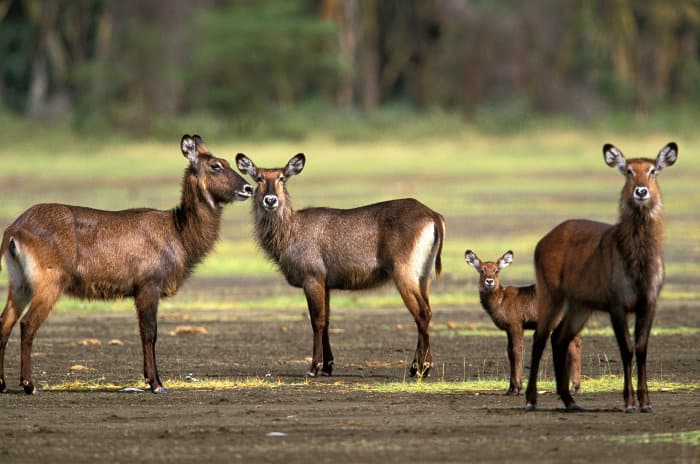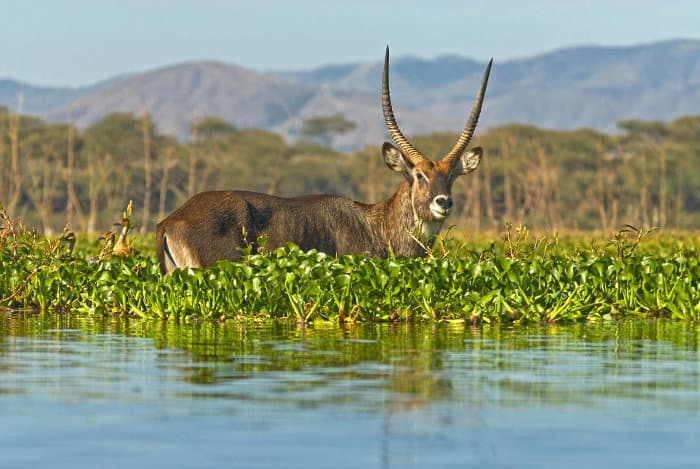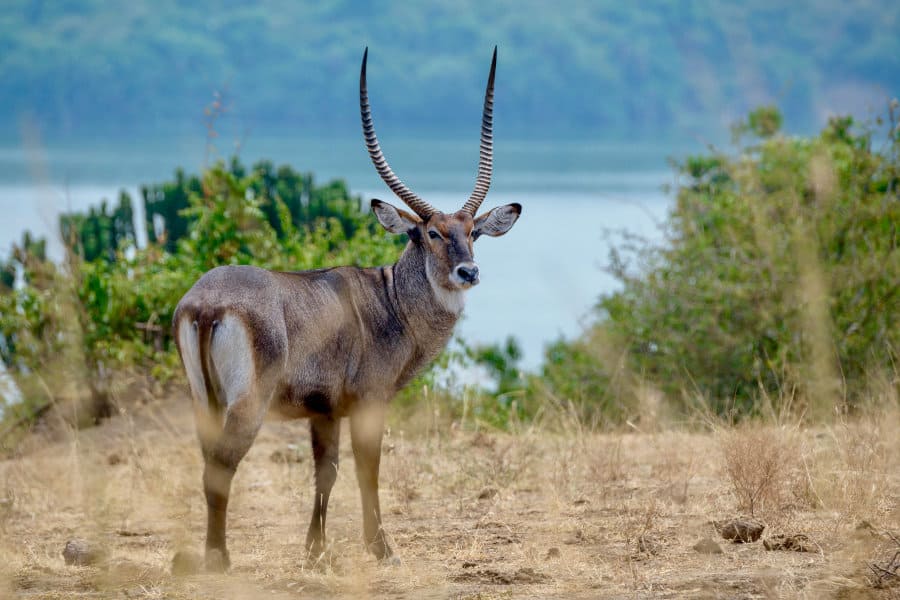If you find yourself on safari in the great Masai Mara, scanning the savanna for animals, you may spot a shaggy antelope and proceed to tick the waterbuck off your list. Yet, if you take a closer look and you don’t see the conspicuous white ring on the backside, then you’re looking at a defassa waterbuck.
One of two waterbuck varieties, the other being the common waterbuck, the defassa waterbuck’s habitat is west of the Gregory Rift Valley. With similar behaviors, diets, and predators, the most remarkable difference between the two is the appearance of their rumps and their population status.
Take a closer look at some interesting defassa waterbuck facts. Next time you’re on safari, you can look out for the near-threatened African antelope.
What Does This Waterbuck Animal Look Like?

These antelopes are pretty cute, with an almost furry-like appearance due to their long, shaggy hair, and large round ears. Female waterbuck don’t have horns while the males boast elegant ringed horns that curve back slightly and grow as long as 100 cm.
Males are larger than females (about 25% larger), standing at about 125 cm and weighing up to 225 kg.
The defassa waterbuck are brown or grizzled-grey all over, with white markings on the face and rump. Besides the telltale white backside, the waterbuck have white patches above the eyes, and on the nose, mouth, and throat.
If you’re picturing a horse-dog-looking animal, you’ve hit the nail on the head.
Kobus ellipsiprymnus defassa Habitat and Range
Much like the common waterbuck, defassa waterbuck live in habitats including savanna grasslands, forests, and woodlands in sub-Saharan Africa.
You’ll find the defassa waterbuck west of the Gregory Rift Valley, their habitat extending from the west of Ethiopia to Senegal and south to Zambia. Habitats of the common and defassa waterbuck overlap in Kenya, Tanzania, and Zambia.
However, it is in the Nairobi National Park in Kenya that there is significant overlap. It is here that interbreeding between the two waterbuck is prominent.
Is the Defassa the Same as a Common Waterbuck?

The common waterbuck and the defassa waterbuck share overlapping habitat ranges. However, the former lives in Southeast Africa and the latter inhabits primarily East and West Africa. Besides their geographical range, there are some physical differences between the two.
Perhaps you’ve heard the African tale about why the waterbuck has a ring on its rump? The legend goes that on a moonless night a waterbuck and her calves wandered into a tribal camp.
One clumsy calf knocked over a bucket of whitewash, creating a big noise. A tribesman came out of his hut, fuming at the mess. He threw the bucket of paint at the mother waterbuck, hitting her perfectly on her behind and leaving a white ring.
Luckily, defassa waterbuck were not around to get attacked with a bucket of paint, and these animals don’t have a ring on their backsides. Rather, it has two solid ring patches on either side of its rump. This is the most telltale physical difference between the two types of waterbuck.
Both waterbuck boast shaggy brown coats and large rounded ears. So, you’ll have to get a peek from behind if you want to identify which waterbuck you’ve spotted. The defassa waterbuck sports a longer tail, but the common waterbuck is taller.
Interestingly, in the overlap of habitats, common waterbuck and defassa waterbuck do interbreed. This interbreeding has led many experts to consider the two waterbuck as a single species, rather than two separate species.
The Near-Threatened African Waterbuck
The IUCN lists the defassa waterbuck as near-threatened. This is surprising considering its cousin across the Rift, the common waterbuck, has a “least concern” status.
So, why are defassa waterbuck numbers declining? Uncontrolled hunting and poaching for bushmeat are the two main culprits behind decreasing waterbuck populations. What’s more, defassa waterbuck are victims of habitat destruction for agricultural purposes and human settlement development.
Thankfully, the majority of the defassa waterbuck population lives in protected national parks such as the Serengeti. There is hope for this furry African buck yet.
It’s Not Actually a Water Antelope

The common misconception about waterbuck is that they love water, or require lots of water to survive. However, the defassa waterbuck and their common cousins aren’t aquatic antelope, such as the amphibious sitatunga.
While the defassa waterbuck is not truly aquatic, it does make a home out of areas close to water. The watery places and long grass provide cover from predators and offer a good place to hide.
These antelopes will head into the water when trying to escape a predator, and they just have to hope that no crocodiles are on the hunt for lunch.
Waterbuck Antelope Fast Facts
Check out these quick facts about defassa waterbuck behavior and life.
- Waterbuck herds are small, comprising of five to ten members.
- Horns begin growing at around nine months old.
- They love munching on coarse grasses that other grazing animals seldom eat.
- Grazing times are usually in the morning and at night, as during the day they rest and ruminate.
- They have a lifespan of up to 18 years.
- Common predators include hyenas, leopards, lions, cheetahs, crocodiles, and wild dogs.
- Waterbuck are quiet and sedentary antelope and don’t migrate or cover great distances.
Look Out for Defassa Waterbuck on Your Next Safari

If you venture out into the well-known national parks of Kenya and Tanzania or the wild protected areas in countries such as Uganda and Cameroon, keep your eyes peeled for the defassa waterbuck. Don’t forget that you’ll need to get a rear view to identify what type of waterbuck you’re looking at!
While these antelope don’t have a target on their backsides, they may as well have, as populations are declining due to poaching and hunting. You can contribute to conservation efforts by simply booking a safari. If you’re lucky, you’ll get a glimpse of these animals in their natural environment.



